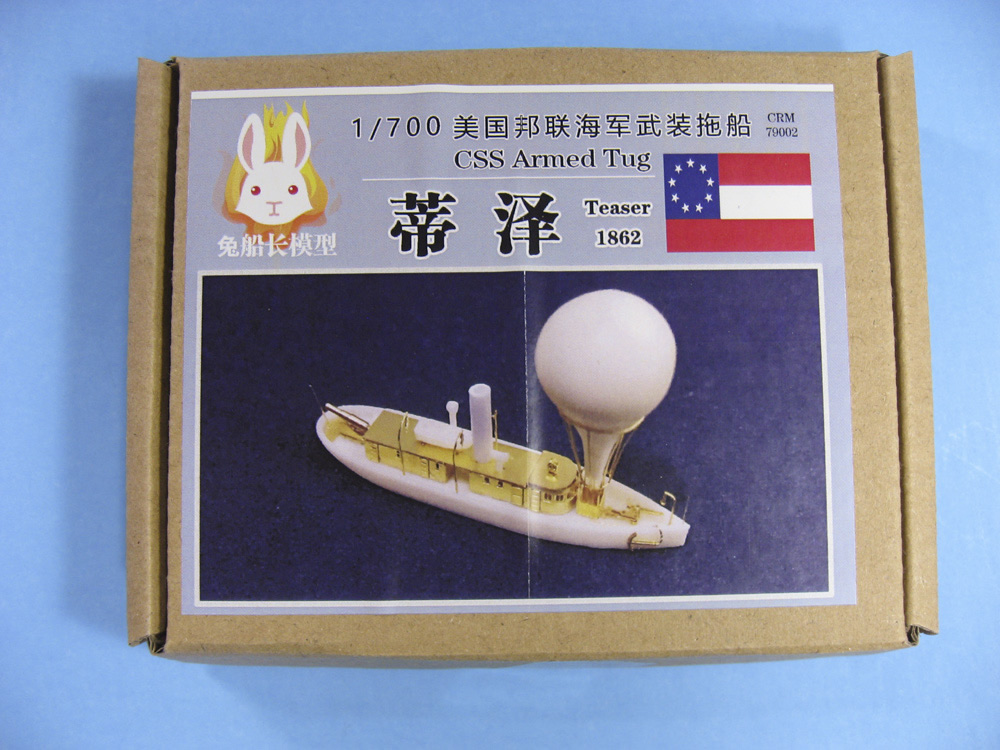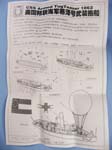| CSS
Teaser

CRM-79002
CRM (?), 1/700 Scale, Resin
Reviewed by Devin Poore, April 2019 |
| CSS Teaser started life as a tugboat,
already well into her civilian career, when the American Civil War started.
Taken into the Confederate Navy, fitted with two guns, she escorted CSS
Virginia
during her historic battle with USS Monitor during the Battle of
Hampton Roads in March, 1862. Later, during the summer of that year, she
served as a balloon tender in Chesapeake Bay. (Note: while there are many
claims of Teaser being "the first US aircraft carrier", and even
"the first aircraft carrier in the world", neither is exactly true. The
Union Navy had been operating the balloon ship George Washington Parke-Custis
in Hampton Roads since late 1861). Later in 1862, Teaser operated
as a torpedo (mine) layer, until captured by USS Maratanza in July
of that year. Taken into the Union Navy, she served through the remainder
of the war as USS Teaser. Sold at public auction in 1865, she worked
in civilian service as a tug until the late 1870's, when she disappeared
from public record. (History compiled from Wikipedia and "War of the
Aeronauts" by Charles M. Evans)
I found this kit while browsing eBay. Referring to the model number
on the box, and the listings of two retailers that carry it and a few other
Civil War era vessels, I believe the Chinese company that produces it is
called CRM, but I could be mistaken; most of the text on the box and in
the instructions is in Chinese. Regardless of who makes it, it's a neat
little model.
Based upon measurements I found online, Teaser is thought to
have been 75 or 80 feet in length. That would translate to approximately
1.37 inches in 1/700. Calipers say the resin hull comes out to 1.38 inches,
which is close enough in my book, considering that the full size lengths
I found are likely based upon questionable sources. Simply put, small vessels
from the mid-19th Century do not have much in the way of documentation.
For instance, there is at least one account that mentions Teaser
as a stern-wheeler. |
| HULL and RESIN PARTS |
| The kit's resin parts come on a runner with the small pieces,
and with the larger balloon and ship's hull as separate castings. The hull
is waterline, smooth on the outside, while the deck has very fine planking
detail and molded bitts. It has a casting plug at the bow, affixed to the
bottom, so removing it should be easy and cause no damage. The balloon
is, well, balloon shaped, with the long lower stem giving the overall piece
a nearly oblong appearance that matches well with contemporary sketches
of the aircraft of the time. The casting runner has several small pieces,
including the two deck houses, two small boats, a vent cowling, and another
small piece that appears to be an auxiliary smoke stack. The ship's main
smoke stack, represented via a hollow piece of styrene tube, is also included
in the small plastic bag with the resin components. |
click images
to enlarge
|

|
|
|
| PHOTOETCH PARTS and
INSTRUCTIONS |
| A 1" X 2" sheet of photo etch contains the detailed components of the
kit. While the deck houses are included as resin parts, they are devoid
of detail. They are to be wrapped with photoetched bulkheads. Not only
are these brass bulkheads included as separate components, they have recesses
etched into them in which separate doors and other details are added. It
seems odd to me that in this tiny scale the doors would not simply be etched
into the brass bulkheads, but this will allow, for those that are really
looking for detail, to model the doors open. Other details, such as a rope
reel, the small fore deck gun, the basket for the balloon, boat davits,
anchor, chains, and gun carriages, are also included on this sheet.
One final brass piece is included in the form of the stern gun. At .15"
long, and .030" at its thickest, to say it's tiny is an understatement.
Don't sneeze or it'll be gone. I believe it's supposed to represent a Brooke
rifle, yet it has too many bands for that, but at that size, who's going
to nit pick?
Finally, the instructions are a single sheet of 8.5" X 11" paper, printed
on a single side. There are numbered call outs of the parts on the brass
sheet with placement details. There are two places where build options
are called out, most noticeably where or not the builder wishes to have
a deck joining the fore and aft deck houses. What little text there is
on the sheet is all in Chinese, but the drawings seem to make the steps
clear enough. |

|
|
|
|
|
| CONCLUSIONS |
| This is a cool little kit. There isn't a lot to it, and
if the brass bulkheads fit the resin cores well, this could be a single-afternoon
build. With the tiny parts, I wouldn't recommend this as a first-time kit
for someone looking to learn working with resin and brass, but it should
be easily buildable for someone with experience. It'd be nice to have a
little more written component to the instructions, but the illustrations
should give you enough to go on. Color schemes are for the builder to figure
out on their own. I've never come across any color recommendations for
the Teaser myself during my American Civil War Navy research, but
I've honestly never specifically looked for it, either. One interesting
aspect as far as color scheme goes: period accounts of Teaser's
balloon reported it had been made of donated silk dresses of many colors,
so that could give the excuse to go outside of the normal military drab
colors.
Review sample courtesy of my own wallet. I purchased it through eBay
company GlobalToy, directly from China. Price was $21, with $5 shipping,
and it arrived three weeks after ordering. |
|